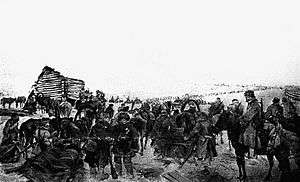Great Siberian Ice March

The Great Siberian Ice march (Russian: Великий Сибирский Ледяной поход, Velikiy Sibirskiy Ledyanoy pokhod) was the winter retreat of Vladimir Kappel's White Russian Army in the course of the Russian Civil War in January–February 1920.
After Admiral Kolchak's White Russian Army retreated from Tomsk and Omsk and fled eastward along the Trans-Siberian Railway, they came to a halt on the shore of Lake Baikal near Irkutsk. With the Red Army in hot pursuit, the White Army had to escape southward to China across the frozen Lake Baikal in sub-zero temperatures. About 30,000 White Army soldiers, their families and all their possessions as well as the Tsar's gold, made their way across the lake to Transbaikalia.
The bloodiest campaign battles occurred at the villages of Yakovlevka, Birulka, and Gruznovskaya, as well as the city of Barguzin.[1]
As the Arctic winds blew unobstructed across the lake, many in the army and their families froze to death. Their bodies remained frozen on the lake in a kind of tableau throughout the winter of 1919–20. With the advent of spring, the frozen corpses and all their possessions disappeared in 5,000 feet of water. Kappel himself was struck by frostbite and pneumonia while leading his survivors along a frozen river in temperatures of -40 °C; he died on 26 January.[2]
Notes
- ↑ Ледяной поход 3-го Барнаульского стрелкового полка (Северный путь) (in Russian). Тернистый путь. Однодневная газета. 1 февраля 1921 г. Издание Владивостокского объединенного комитета по устройству недели каппелевцев. Retrieved 2009-11-08.
- ↑ Evan Mawdsley. The Russian Civil War. Pegasus Books, 2007, p. 211. Retrieved 18 April 2010.
